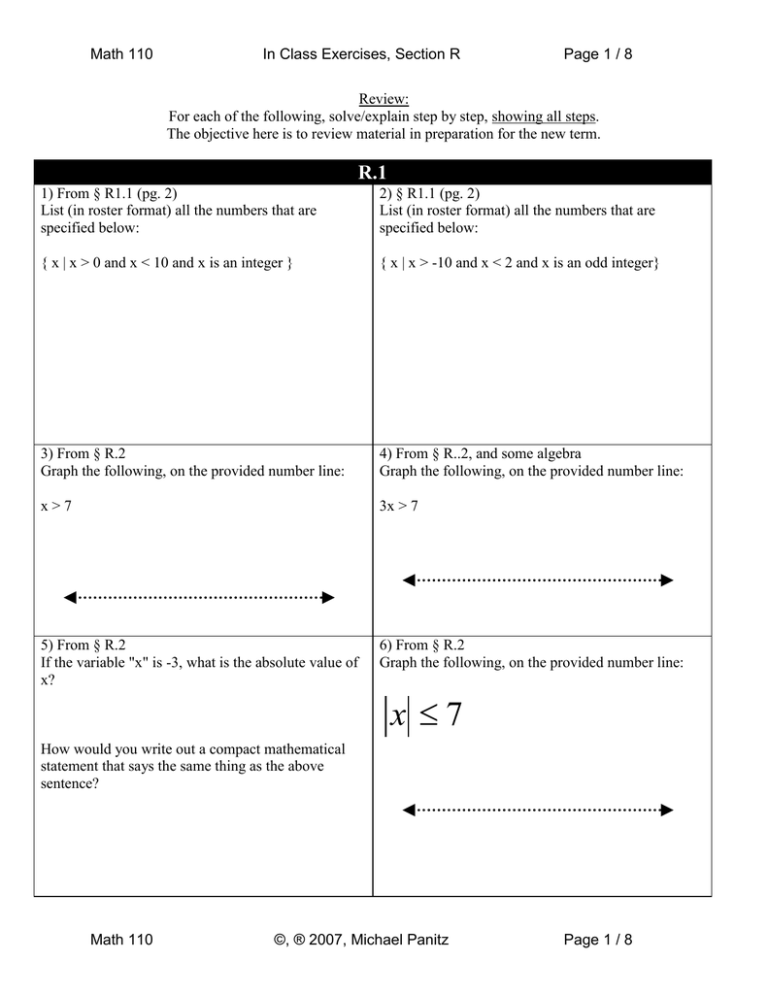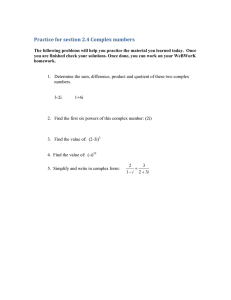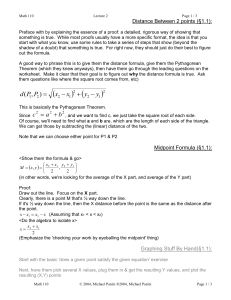Exercises - Section R
advertisement

Math 110
In Class Exercises, Section R
Page 1 / 8
Review:
For each of the following, solve/explain step by step, showing all steps.
The objective here is to review material in preparation for the new term.
R.1
1) From § R1.1 (pg. 2)
List (in roster format) all the numbers that are
specified below:
2) § R1.1 (pg. 2)
List (in roster format) all the numbers that are
specified below:
{ x | x > 0 and x < 10 and x is an integer }
{ x | x > -10 and x < 2 and x is an odd integer}
3) From § R.2
Graph the following, on the provided number line:
4) From § R..2, and some algebra
Graph the following, on the provided number line:
x>7
3x > 7
5) From § R.2
If the variable "x" is -3, what is the absolute value of
x?
6) From § R.2
Graph the following, on the provided number line:
x 7
How would you write out a compact mathematical
statement that says the same thing as the above
sentence?
Math 110
©, ® 2007, Michael Panitz
Page 1 / 8
Math 110
In Class Exercises, Section R
Page 2 / 8
R.2.5
For all of the following exercises, keep the numbers as fractions (don't use your calculator)
7) Negative Exponent Rule:
a m
1
am
y
3
x
2
3
1
x
3
5
2
3
8) Product Rule:
a m an amn
1
3
A) x x
2
1
3
7
2
B) z z
3
C) z z
2
9
9) Zero Exponent Rule:
1
a 1
x x
0
1
x
1
4
1
4
x
x
4
6
x
10) Quotient Rule:
m
a
a mn
n
a
x
z3
2
z
x
3
7
2
7
y
y
1
13
3
39
11) Raising A Power To A Power Rule:
(a ) a
m n
m n
x
3 2
d
4x
1
3 2
x
2
3
1
2
12) Raising A Product To A Power Rule:
(ab) m a m b m
Math 110
xy
2
3 3
©, ® 2007, Michael Panitz
4x
1
3 3
Page 2 / 8
Math 110
In Class Exercises, Section R
Page 3 / 8
13) Raising A Quotient To A Power Rule:
a m am
( ) m
b
b
2
x
y
1
2
9
2
y
2
9
16
14) Calculator Practice
Try obtaining actual numbers for the following expressions (evaluate each expression)
(On the TI-83, you can do this by first typing in the base, then the "raise to" key (it looks like ^, and it's right
above the blue "divide by" key (÷). Then push the enter key to have your calculator evaluate it.
It should look like:
2^3<Enter>
8
2
0 .5
3
4
6
4
5
B)
D)
C)
E)
A)
For part C, translate the result your calculator gave you (in scientific notation) into decimal (normal) form:
2 .5
4
0.1
R.3
15) From § R.3.1
What is the Pythagorean Theorem?
16) From § R.3.2
What is the area of the given shape?
height of
this = 1
Given the following right triangle, what is the length
of the hypotenuse?
length
of
this
side=4
height of this side=2
length of this side=3
length of this side=3
Math 110
©, ® 2007, Michael Panitz
Page 3 / 8
Math 110
In Class Exercises, Section R
Page 4 / 8
R.4
17) For the following expression:
4x3 x 7
What is the leading coefficient?
What is the coefficient of the second term?
What is the degree of the expression?
18) Add or subtract as indicated, so as to end up with as few terms as possible:
x
2
5 x 2 x 3 2 x 2 7 x 10
19) Add or subtract as indicated, so as to end up with as few terms as possible:
yx
2
5x 2 y 2 x 3 2 x 7 yx 10 y 2
20) Multiply or divide as indicated:
x 1x 1
Can you use any of the special product formulas? (Pgs 39,40)
21) Multiply or divide as indicated:
x 12
Can you use any of the special product formulas? (Pgs 39,40)
22) Multiply or divide as indicated:
x 1x 2 y 3
Can you use any of the special product formulas? (Pgs 39,40)
Math 110
©, ® 2007, Michael Panitz
Page 4 / 8
Math 110
In Class Exercises, Section R
Page 5 / 8
23) Do the following division, then check your work by multiplying the divisor by the result (the quotient),
and making sure that it's the same as the dividend you started with.
x 3x 3 4 x 2 x 7
24) Do the following division, then check your work by multiplying the divisor by the result (the quotient),
and making sure that it's the same as the dividend you started with.
x 2 4 x 3 3x 2 x 1
25) Do the following division, then check your work by multiplying the divisor by the result (the quotient),
and making sure that it's the same as the dividend you started with.
x 2 1 3x 3 4 x 2 x 7
Math 110
©, ® 2007, Michael Panitz
Page 5 / 8
Math 110
In Class Exercises, Section R
Page 6 / 8
R.5
26) Factor by any means possible
x 3 27
27) Factor by any means possible
x 3 27
28) Factor by any means possible
x 2 16
29) Factor by taking advantage of the fact that this is a perfect square:
x 2 2x 1
30) § R.6. Factor by taking advantage of the fact that this is a perfect square:
x 2 4x 4
31) Factor by any means possible:
x 2 9x 8
32) Factor by any means possible:
3x 2 2 X 8
Math 110
©, ® 2007, Michael Panitz
Page 6 / 8
Math 110
In Class Exercises, Section R
Page 7 / 8
Rational Expressions (R.7)
(Note: You may need to review factoring (R.5) prior to doing this work)
33) Simplify / reduce to lowest terms
3x 9
x2 9
34) Simplify / reduce to lowest terms
y 2 25
2 y 2 8 y 10
35) Simplify / reduce to lowest terms
12 x
5 x 20
4x2
x 2 16
36) Simplify / reduce to lowest terms
x
2x 3
x 1 x 1
Math 110
©, ® 2007, Michael Panitz
Page 7 / 8
Math 110
In Class Exercises, Section R
Page 8 / 8
R.8
37) Show what the result of the following operations are. First try to figure out the answer by hand, then by
using your calculator
49
2
21 2 x
f(x) =
find f(5).
where x = 2
12 x 4 ,
Then find f(-2)
38) Rewrite each radical expression into an expression that has rational exponents
49
2
192 x
7
12 x 4
13
x 2 4
39) Write each expression without rational exponents (i.e., in radical form), then simplify as much as possible
(1728)
1
3
8
1
3
1
4 8 2
(64 x 4 y z )
15
x5
40) Simplify:
x y
3
1
3 3
4
x 6 y 23
300 x 3
3x
41) Solve for x. Remember to check for extraneous "solutions"!
2 x 29 3 0
42) Simplify (get the complex number out of the denominator):
2 3i
2i
Math 110
©, ® 2007, Michael Panitz
Page 8 / 8


